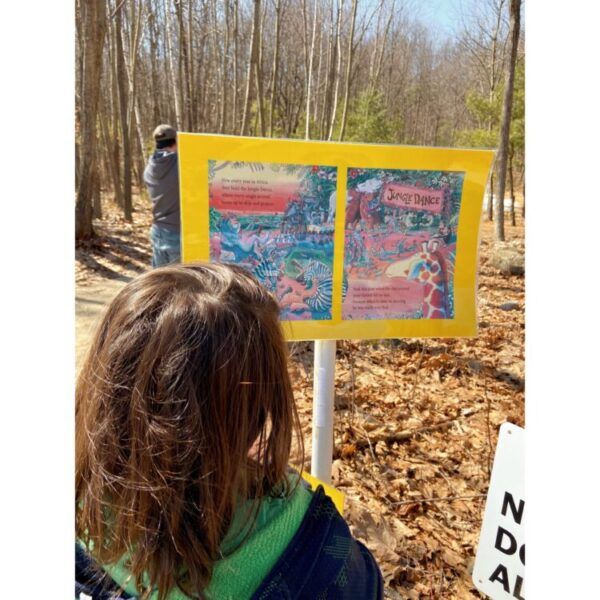When Anne Ferguson was working with the Vermont Department of Health, she created The StoryWalk® Project as a way to convince families to get outside and be active while engaging with literacy. She was on the hunt to create something that required the adults to be active alongside children, with no financial limitations that would leave some families out. StoryWalk was born.
Where do you put a StoryWalk?
The original goal for The StoryWalk Project was to have stories placed outside in nature. Public walking trails are a natural and obvious place to start, but the project has expanded to include city settings such as main street businesses and school playgrounds. If you consider that the aim is to have families moving outside, any safe route that lets you space out pages can be used. In my city, I’ve spotted books spaced along the walking trail that circles a local pond, and around the circumference of our city-owned working apple orchard. There are, of course, practical considerations that need to be addressed. Spaces that take a hard hit from the elements (super high winds, for example) are not ideal. Anne Ferguson hilariously shares these tips for avoiding damage caused by humans in her StoryWalk History: “Vandals are a recurring challenge. They seem to be threatened by a story about Gossie, a small duck who has misplaced his red rubber boots. A range of approaches has been used to address this issue, some with greater success than others. The Velcro® makes it easy to take down the pages before dark and post them again in the morning. Vandals prefer the cover of darkness.”
How do you make a StoryWalk?
What books are good for a StoryWalk?
There is a lot to consider when choosing a title. It’s important to have engaging illustrations and pages that don’t include too much text. A plot-driven story that will motivate the families to find the next page is extremely helpful. Different communities and even areas within your community might have different literacy needs, including languages spoken and messages conveyed. There are a few instances in the Northeastern U.S. of StoryWalk libraries, where community organizations can borrow titles already prepared for StoryWalk. The Massachusetts Department of Early Education and Care has five resource centers with StoryWalk books available. Anne Ferguson herself has a collection of books available to borrow for up to two weeks, which are let through the Kellogg-Hubbard Library in Montpelier, Vermont.
Looking to install a StoryWalk in your community?
Hopefully you’ve found some tips to help you better understand StoryWalks, and maybe even been inspired to sponsor one of your own!
